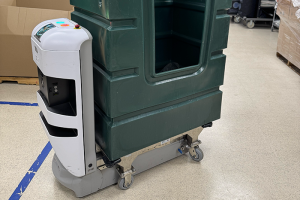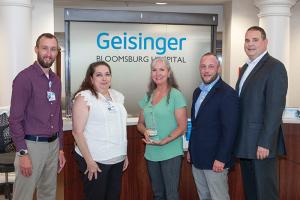Technology helps streamline patient room turnover
We love to pull for the underdog: Rudy, the Karate Kid and the 1980 U.S. men’s Olympic hockey team, to name a few. This particular underdog story is about an environmental services staff that became empowered by a long-awaited technology.
In 2012, University of California, San Francisco (UCSF), Medical Center began planning operations for its Mission Bay campus, and nursing identified a need to fix the patient-room turnover process, in which different hospital units required different room set-ups that nurses could not always agree on.
During peak discharge times, housekeepers floated to unfamiliar units with unclear expectations. Supervisors continually put out fires and were buried under piles of months-old inspection reports.
Inspired by David Radcliff, support services director, Northwestern Medicine Central DuPage Hospital in Winfield, Ill., UCSF adopted the “Room Ready” model. The concept is simple. Environmental services and nursing agree on each unit’s standard room set-up and hold each other accountable.
The program solved UCSF’s room turnover problems, with one exception: mountains of paper records. Seeking an automated solution, UCSF implemented ReadyList software to host room turnover agreements. However, robust training was most essential. Two patient room cleaning personnel rose to the occasion: Reyna Valencia and Judith Gonzalez.
Moving environmental services online brought additional benefits. ReadyList gives managers and supervisors up-to-the-minute visibility to cleaning progress throughout the facility. Housekeepers record daily cleans.
Those who fall behind are identified, helped and then retrained. Reports – prepared monthly and delivered via email – show quality scores by unit, cleaning activities that require retraining and other institutional trends. The most extraordinary benefit, however, has been the staff response. Distinct cleaning expectations help housekeepers to perform excellent cleans.
Floor care will be the next function to move online. ReadyList will store floor care instructions for a diverse set of machines across a spectrum of surfaces. It also will track machine usage and maintenance.
Separately, Gonzalez recently completed education to become a pharmacy technician. Valencia is entertaining an opportunity to become a supervisor. Employee empowerment has led to professional growth and the underdog story continues!
Chris Henderson is hospitality services manager at the University of California, San Francisco, Medical Center, Mission Bay campus.
Practice guidance available
Practice Guidance for Healthcare Environmental Cleaning, second edition, helps to define and advance the professionals responsible for care of the health care environment to ensure high-quality outcomes and healthy communities. This manual provides evidence-based research, guidance and recommended practices that should be considered for inclusion in health care environmental services departments. Because each facility has its own needs, this resource has been designed to enhance an existing program. For more information, visit www.ahe.org/ahe/learn/tools_and_resources/publications.shtml.
Certified Healthcare Environmental Services Technician Certificate
This certification focuses on critical areas of competency for front-line technicians, including infection prevention, quality of care, patient outcomes and experience. For more information, visit www.ahe.org/ahe/lead/CHEST/chest_home.shtml.
Environmental Sustainability Certificate Program
AHE has launched a certification to acknowledge the environmental and ecological sustainability efforts of environmental services departments. For more information, go to www.ahe.org/ahe/lead/environmental_sustainability_ certificate_program.shtml.



